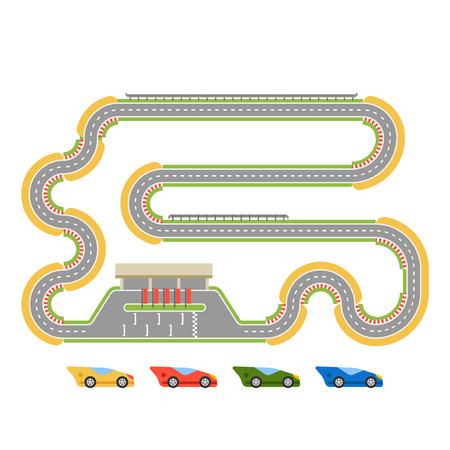Introduction: The Allure of Street Racing
Street racing has long captured the imagination of Americans, from Hollywood blockbusters to late-night news stories. The thrill of pushing a car to its limits, the rush of adrenaline as engines roar down empty city streets, and the camaraderie among drivers all contribute to the ongoing appeal of illegal street racing in the U.S. While its often portrayed as a rebellious subculture, street racing is more than just fast cars and risky moves—its a phenomenon fueled by the desire for excitement, recognition, and an escape from everyday routines. Despite the dangers and legal risks, many are drawn to this underground world because it promises both intense excitement and the chance to prove oneself behind the wheel. Understanding why so many are willing to take these risks starts with exploring the cultural fascination that surrounds street racing across America.
2. The Risk Factor: Legal and Physical Consequences
Street racing is often glamorized in movies and pop culture, but the reality is far from thrilling when you consider the risks involved. Participating in street races exposes drivers to a wide range of dangers that go beyond just getting caught by the police. The consequences can be both legal and physical, affecting not only the racers themselves but also innocent bystanders and other road users.
Legal Penalties
Law enforcement agencies across the United States take street racing seriously, implementing strict penalties to deter this illegal activity. Getting caught can lead to severe repercussions that impact your record, finances, and freedom. Here’s a breakdown of common legal penalties associated with street racing:
| Consequence | Description |
|---|---|
| Fines | Hefty fines ranging from several hundred to thousands of dollars depending on state laws. |
| License Suspension | Immediate suspension or revocation of your drivers license for months or even years. |
| Vehicle Impoundment | Your car may be impounded for weeks or permanently confiscated. |
| Jail Time | Repeat offenders or those causing injuries may face jail sentences. |
| Criminal Record | A conviction can stay on your record, affecting employment and insurance rates. |
Physical Dangers: Injuries and Fatalities
The risks of street racing extend far beyond citations and court dates. High speeds, unpredictable environments, and lack of safety measures make these races extremely dangerous. The potential for serious injury or death is significant—not just for the drivers but also for passengers, pedestrians, and other motorists who might be in the wrong place at the wrong time.
Main Physical Risks:
- Severe Injuries: Broken bones, traumatic brain injuries, spinal cord damage, and internal bleeding are all common outcomes after high-speed crashes.
- Fatalities: According to the National Highway Traffic Safety Administration (NHTSA), hundreds of lives are lost each year due to street racing incidents across the country.
- Bystander Harm: Innocent people—often children or families—can become unintended victims when races spill over into residential neighborhoods or busy streets.
The Ripple Effect on Communities
The fallout from a single street race can ripple through entire communities, leading to increased insurance premiums, strained emergency services, and a heightened sense of danger on local roads. While some thrill-seekers may downplay these consequences in pursuit of adrenaline, the reality is that every street race is a gamble with stakes far higher than most are willing to pay.

3. The Psychology Behind the Wheel
Many drivers who participate in street racing are motivated by complex psychological factors that go beyond a simple love of cars or speed. One of the primary reasons is thrill-seeking behavior. For these individuals, the rush of adrenaline from pushing their vehicles to the limit and the danger involved creates an intoxicating experience that everyday life rarely offers. This need for excitement can become almost addictive, driving people to take greater risks each time they race.
Peer pressure is another significant force that pulls drivers into the world of illegal racing. Especially among younger participants, there is a desire to fit in with a certain group or earn respect from fellow enthusiasts. When friends encourage or even dare someone to race, it becomes difficult to refuse without feeling left out or appearing cowardly. The street racing scene often thrives on this sense of community and competition, where reputation is built not just on skill, but also on boldness.
Additionally, the quest for social status plays a major role. In some circles, winning a street race brings more than just bragging rights—it can elevate someone’s standing within their peer group or local car culture. Social media amplifies this effect, as videos and photos of daring races can quickly rack up views, likes, and comments, further fueling the desire for recognition and validation.
Together, these psychological drivers create a powerful mix of motivations that can override concerns about safety or legality. For many racers, it’s not just about the cars—it’s about proving themselves in front of others and experiencing a sense of belonging and accomplishment that might be hard to find elsewhere.
4. Social Media and Pop Culture Influence
One of the driving forces behind the popularity of street racing in America is its portrayal in movies, music, and especially on social media platforms. Over the last few decades, Hollywood films like “The Fast and the Furious” franchise have glamorized street racing, transforming it from a risky underground activity into a thrilling spectacle. These movies often focus on themes of brotherhood, adrenaline, and rebellion, making street racing appear alluring and even heroic to viewers.
Similarly, popular music genres—especially hip-hop—frequently reference fast cars, high-speed chases, and living life on the edge. Lyrics and music videos showcase luxury vehicles, flashy modifications, and a lifestyle that many young Americans find aspirational. This constant exposure normalizes and even glorifies risky behavior behind the wheel.
But perhaps the most significant influence comes from social media. Platforms like Instagram, TikTok, and YouTube are filled with videos of high-speed races, car stunts, and behind-the-scenes looks at car builds. With millions of views and shares, these clips create a sense of community among enthusiasts while simultaneously desensitizing viewers to the dangers involved.
How Pop Culture Shapes Perception
| Medium | Street Racing Portrayal | Impact on Public Perception |
|---|---|---|
| Movies (e.g., Fast & Furious) | Exciting plots featuring skilled drivers and dramatic races | Makes street racing seem glamorous and heroic |
| Music (Hip-hop/Pop) | Lyrics about fast cars, risk-taking, and wealth | Associates street racing with success and coolness |
| Social Media | User-generated content showcasing real-life races and car culture | Normalizes illegal behavior; creates viral trends |
The Viral Effect of Street Racing Content
With content going viral in seconds, social media has accelerated the spread of street racing culture across the U.S. Hashtags like #streetracing or #carmeet draw in millions of views, encouraging others to participate for internet fame or peer recognition. This digital validation can be especially powerful for younger drivers looking for identity or community online.
The Double-Edged Sword of Exposure
While pop culture and social media have undeniably boosted the appeal of street racing by making it look exciting and rewarding, they often overlook or minimize the severe risks involved—both legal and physical. As these influences continue to shape public perception, understanding their impact is crucial in addressing why so many drivers are willing to take such dangerous chances.
5. The Rewards: What Drivers Stand to Gain
For many street racers, the risks are matched by a powerful set of rewards that go far beyond simple adrenaline.
Bragging Rights and Reputation
At the heart of the street racing scene is the pursuit of bragging rights. Winning a race, especially against a well-known or skilled opponent, earns drivers respect within their circles. These unofficial victories are often talked about for weeks or even months, cementing the winner’s reputation as someone who “owns” the streets. In tightly knit communities, this kind of recognition can be more valuable than any trophy.
Financial Incentives
While not every race involves money, bets and cash prizes are an undeniable draw for some participants. Races can be organized with sizable entry fees or side bets, sometimes reaching thousands of dollars. For those willing to risk it all, the financial payoff provides an extra layer of motivation—and sometimes even a way to support car modifications or other racing expenses.
A Sense of Belonging
Street racing isn’t just about cars and competition; it’s also about community. For many drivers, being part of this underground world offers a sense of belonging they might not find elsewhere. Racers bond over shared interests in cars and speed, forming close friendships and tight crews that look out for each other on and off the road. These relationships help create a support system that draws people deeper into the scene.
The Thrill Factor
The excitement and rush that come from pushing limits in a high-stakes environment can be addictive. The combination of danger, speed, and skill required makes every win intensely satisfying—fueling a desire to keep coming back for more.
Building Status Beyond Racing
Winning races or being known as a top-tier driver often opens doors outside the immediate street racing world. It can lead to opportunities in legal motorsports, car shows, or even sponsorships from local businesses interested in tapping into the culture. In these ways, the rewards extend past the finish line—making the risks worth it for many drivers.
6. Law Enforcement and Community Response
Street racing poses serious risks to public safety, prompting a strong response from law enforcement across the United States. Police departments utilize a variety of strategies to deter illegal racing, including increased patrols in known hot spots, surveillance technology such as traffic cameras, and undercover operations targeting organizers. In many cities, specialized task forces have been established to focus exclusively on street racing incidents, often coordinating with state and federal agencies to identify and prosecute offenders.
Beyond direct enforcement, authorities also employ prevention efforts aimed at reducing the appeal of street racing. Programs like “Take It to the Track” encourage drivers to race legally in controlled environments, providing a safer alternative and education about the consequences of illegal racing. Public awareness campaigns leverage social media, local news outlets, and school outreach to highlight the dangers associated with street racing—not only for participants but for innocent bystanders as well.
Local communities play an active role in combating street racing by advocating for stricter penalties, supporting noise ordinances, and organizing neighborhood watch groups. Many neighborhoods collaborate with city officials to install speed bumps or redesign streets to discourage high-speed driving. Community advocacy groups also work alongside law enforcement to gather information about upcoming races and push for policy changes that prioritize pedestrian safety.
Overall, the combined efforts of law enforcement and community organizations reflect a commitment to addressing both the symptoms and root causes of street racing culture. While these strategies have made progress in some regions, continued innovation and cooperation remain essential as street racers find new ways to evade detection and organize clandestine events.
7. Conclusion: Weighing the Risks and Rewards
The debate over street racing continues to divide communities, law enforcement, and even car enthusiasts themselves. On one hand, street racing offers adrenaline, thrill, and a sense of belonging that appeals especially to younger drivers searching for excitement and social validation. On the other, the dangers are undeniable—ranging from severe legal consequences to tragic loss of life. As society grapples with how to address this risky subculture, perspectives differ on the best path forward.
Some advocate for tougher laws and increased police presence, hoping that strict enforcement will deter would-be racers. Others push for more community-based solutions like sanctioned race tracks or safe driving programs that channel automotive passion into less hazardous outlets. Education also plays a vital role—raising awareness about the real-world consequences of reckless driving can influence decision-making and foster safer behaviors on the road.
Ultimately, finding a balance between acknowledging the appeal of street racing and promoting public safety requires cooperation from all sides. Solutions may involve not only legal reforms but also investment in infrastructure, outreach initiatives, and opportunities for responsible car culture expression. The risks may never fully disappear, but by working together, communities can help ensure that the rewards of car enthusiasm are enjoyed without putting lives at stake.


